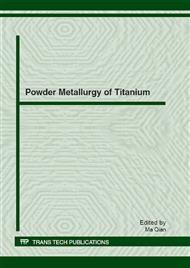p.195
p.201
p.208
p.214
p.220
p.226
p.234
p.242
p.248
Direct Metal Laser Sintering of a Ti6Al4V Mandible Implant
Abstract:
The aim of this study is to investigate the direct manufacturing of a titanium mandible implant via a laser sintering process which involves the different areas of medicine, engineering and product design. The manufacturing and challenges for producing customised titanium implants are described in this work. Implant data and its functional requirements of loading and fixation are established based on CT scan data. The process of converting different types of data from CT scans to 3D design and then to readable machine data and its associated processing software are illustrated and explained. The mandible tray was designed with a predefined porous structure to reduce weight and stimulate better bio-factor delivery at the same time. The laser sintering process and its critical steps for producing a tailored structure and complex shape are reported. This includes titanium powder preparation, processing parameters, support structures, model inclination, post-processing works and associated costs. Results show that it is possible to fabricate a customised mandible implant with a complex structure and having sufficient detail through the laser sintering process. This technique provides a platform to respond quickly and build accurate parts with good surface finish.
Info:
Periodical:
Pages:
220-225
Citation:
Online since:
August 2012
Authors:
Keywords:
Price:
Сopyright:
© 2012 Trans Tech Publications Ltd. All Rights Reserved
Share:
Citation:


